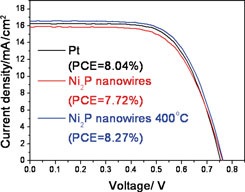Crossref Citations
This article has been cited by the following publications. This list is generated based on data provided by
Crossref.
Wu, Mao-Sung
and
Wu, Jia-Fang
2013.
Pulse-reverse electrodeposition of transparent nickel phosphide film with porous nanospheres as a cost-effective counter electrode for dye-sensitized solar cells.
Chemical Communications,
Vol. 49,
Issue. 93,
p.
10971.
Wu, Mao-Sung
Chung, Che-Ju
and
Ceng, Zhi-Zhen
2015.
Cyclic voltammetric deposition of discrete nickel phosphide clusters with mesoporous nanoparticles on fluorine-doped tin oxide glass as a counter electrode for dye-sensitized solar cells.
RSC Advances,
Vol. 5,
Issue. 6,
p.
4561.
Theerthagiri, Jayaraman
Murthy, Arun Prasad
Lee, Seung Jun
Karuppasamy, K.
Arumugam, Senthil Raja
Yu, Yiseul
Hanafiah, Marlia M.
Kim, Hyun-Seok
Mittal, Vikas
and
Choi, Myong Yong
2021.
Recent progress on synthetic strategies and applications of transition metal phosphides in energy storage and conversion.
Ceramics International,
Vol. 47,
Issue. 4,
p.
4404.
He, Y.
Yue, G.
Huo, J.
Dong, C.
Xie, G.
and
Tan, F.
2023.
A dye-sensitized solar cells with an efficiency of 10.01% based on the MoP/MoNiP2@Ti3C2 composite counter electrode.
Materials Today Sustainability,
Vol. 22,
Issue. ,
p.
100329.
Fan, Zhe
Chen, Xu
Shi, Xiaoqing
Jiang, Qiwei
and
Zhang, Yang
2023.
Facile synthesis of NiS nanowires via ion exchange reaction as an efficient counter electrode for dye-sensitized solar cells.
Journal of Materials Chemistry C,
Vol. 11,
Issue. 16,
p.
5348.
Lozano Gutiérrez, G.I.
Ornelas Dávila, O.
López Aguilar, C.
Dávila Jiménez, M.M.
Silva González, R.
Sirés, I.
Brillas, E.
Fabregat-Safont, D.
Roig Navarro, A.F.
Beltrán Arandes, J.
and
Sancho Llopis, J.V.
2023.
Electrochemical oxidation of meglumine in a pharmaceutical formulation using a nanocomposite anode.
Electrochimica Acta,
Vol. 437,
Issue. ,
p.
141457.
Li, Kexin
He, Ye
Yue, Gentian
Gao, Yueyue
Dong, Chen
and
Tan, Furui
2024.
Construction of magnetic Fe2P2O7/Ni2P@Mxene composite counter electrode for efficient dye-sensitized solar cells.
Vacuum,
Vol. 222,
Issue. ,
p.
112982.





